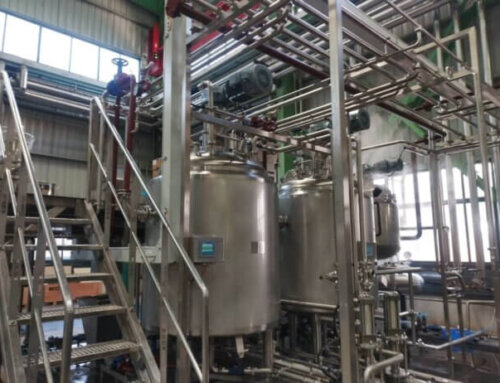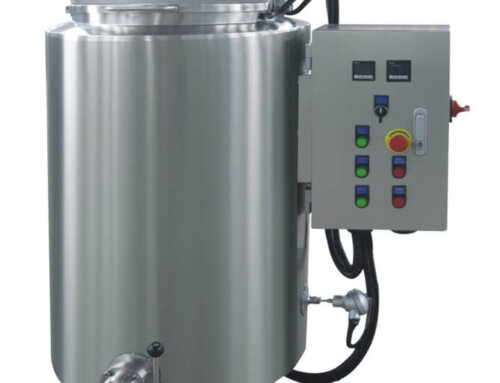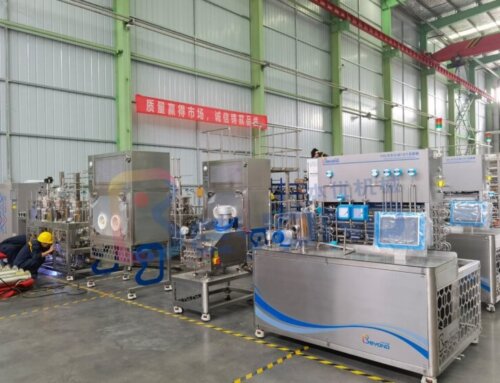Peanut Milk Production Plant Description
1. Peanut milk is a plant-based milk beverage with high nutritional value made from peanut kernels. It contains 8 essential amino acids, high content of unsaturated fatty acids and vitamin E, milky white color, pure aroma, and delicate and smooth taste, suitable for public consumption.
2. The whole peanut milk production line mainly includes peanut soaking tank, peanut blanching machine, peanut red coat peeling machine, peanut pulp grinding machine, peanut pulp separating machine, peanut milk blending tank, peanut milk homogenizer, degasser and sterilizer system, peanut milk filling and packing system.
3. The ingredients of the peanut milk that can be added are salt, sugar, cow milk, Vitamin, Emulsifiers and stabilizers, flavor agents etc.,
4. The peanut production line can produce peanut milk or peanut butter according to client’s requirements, and the end products can be filled into bottles, cartons, and metal cans. The peanut milk processing plant is from 500L/H-10000L/H.
5. The peanut processing machine is made of SUS304 material, and the whole processing line is equipped with CIP cleaning system to ensure the hygiene requirements of food production.

Peanut Milk Production Plant Technological Flowchart
After the peanut kernels are sorted, soaked in hot water, the outer red seed coat is removed, after colloid grinding, the solids in the pulp are separated by a screen filter or centrifuge separator, and then flavor substances are added to the mixing tank. After mixing, homogenization, UHT sterilization, and then filling into bottles or carton packaging. In the case of bottled hot-filling, the filled container needs to be re-sterilized through a retort before it can be packaged and put into storage. The shelf life of the products produced in this way can reach 12 months.
Peanut Milk Production Plant Key Equipment Introduction
Peanut sorting machine: Choose peanut kernels with small grains, high protein content, and strong flavor. The storage period should not exceed one year. Pick and remove mold, moth, buds and thin nuts.
Peanut Soaking and Peeling Machine: The peanut kernel contains lipoxygenase, which will promote the green and astringent taste of peanut milk. The red seed coat pigment of the peanut kernel affects the color of the product, and the red seed coat tannin affects the taste of the product. Therefore, the enzyme should be inactivated and the peanut red seed coat should be removed before pulping. At present, the commonly used method is to soak the peanut in the soaking tank for 20-30S with hot water of about 95℃, and then send the peanut kernels to the peeling machine for peeling. The peeling rate of peanuts in this method is 99%.
Enzyme-inactivating: Peanut kernels after peeling need to be de-enzymes in a blanching machine, the temperature is controlled at about 95℃, and the blanching time is 2-3min.
Peanut Refining Machine: Peanut refining generally adopts the two-stage refining method, which can be realized by colloid milling. When refining, the ratio of peanut kernel and water is about 1:10. Depending on the rate at which water is added, the colloid mill can produce peanut butter or peanut milk. After colloid mill refining, the fineness of peanut pulp reaches 100 -200 mesh. If the slurry is too thick, the cell tissue is not fully destroyed, and the protein cannot be fully extracted, thereby reducing the nutritional value of the beverage; If the slurry is too fine, which is not conducive to the separation of the slurry and affects the filtering effect. The extraction rate of peanuts is generally 60%-70%, and after refining, the peanut pulp has fine and smooth texture and white color. In the refining process, hot alkaline water refining can also be used, so that more than 95% of the oil in the peanut kernels can be extracted. In addition, the hot alkaline water can also inhibit the activity of lipoxygenase and improve the flavor of peanut milk.
Peanut Pulp Filtration: mainly to separate the large particles and solids in the peanut pulp. This step can be completed by a vibrating screen or a centrifugal separator.
Peanut milk Blending: The raw materials used to make peanut milk include peanut pulp, sugar, emulsifier, stabilizer thickener, spices, etc. The emulsifier and stabilizer can be mixed with peanut pulp during the preparation, and then mixed with the syrup. the blending temperature of the peanut milk is controlled at 60-65°C. The formula of peanut milk can be based on peanut kernels 6%-10%, sugar 5%, emulsion stabilizer 0.2%-0.3%, drinking water 80%-85%.
Homogenization: To prevent the particles in the peanut milk from sinking and floating, the particle diameter must be reduced, which can be achieved by homogenization. High-pressure homogenization is carried out at a temperature of 55-70°C to further refine protein ions and fat globules, and the homogenization pressure is 30-35MPA.
Vacuum degassing: A vacuum degassing machine is used to degas the homogenized peanut milk to reduce the oxygen content, prevent fat oxidation, maintain the product flavor, and extend the shelf life of the peanut milk.
Peanut Milk Sterilization and Filling Machine: The main packaging forms are tinplate cans, glass bottles, etc. for peanut milk, if they are filled into this type of packaging, they can be pasteurized before filling (optional), and the filled containers are then put into the sterilization kettle for secondary sterilization, heat the peanut milk to 121°C for 20 minutes, and then cool it to room temperature for packaging; If it is filled into an aseptic carton, it must be sterilized by UHT before filling, and instantaneously sterilized at 137°C and heat preservation for 3-5S.




